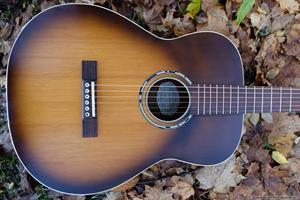I made an advanced repair on a "new" Levin from 1954. The neck had to be replaced and it was bent. A carbon fiber rod would be mounted. The fretboard was flat and could just as easily be replaced with a new one in Madagascar rosewood with a 16 ″ radius with EVO Gold frets. The binding on the fretboard and all the dots were skipped for a all wooden and sober fretboard. To get the guitar sounding as good as possible, it also got a segmented saddle bone and nut intonation. Only one thing was missing from a complete mod and that was a bridgeplate in spruce with plugs. I tried to loosen the bridgeplate in maple through the soundhole and it came loose surprisingly easily, the glue was not the best. I glued in an new bridgeplate in spruce with plugs and buttons in bubinga around the string pin holes
The only thing lacking for a complete GammelGura modification was that the bottom was not opened and that the original braces was not replace in a better pattern. In 1954, Levin had stopped installing the tone-killing birch slab across the top under the bridge, this one had two spruce braces instead. A perfectly OK solution. The original tuners with their special knobs were allowed to remain as well. They are really sluggish, despite all the attempts to lubricate them, and you have to use a lot of force to tune up. They can be easily replaced with modern tuners as the distance between the posts is the modern USA standard as all tuners nowadays.
A crack in the middle joint on the top under the strings had a spruce strip glued in. It also put a coat of clear spirit varnish on top of the old water-sensitive variant of cellulose varnish that Levin used in the 1950s. The spirit varnish, which is about 90% shellac, attaches to everything! A string pin was broken, but I had a spare one in stock.
The disgusting yellow color that is always found on the rosewood bridge of these Levin guitar hides a very fine rosewood behind a thick layer of extremely hard varnish. The varnish can be removed, but you have to use a grater, coarse sandpaper, a sharp knife and sickle and a few swear words before you get rid of it! The wood in the bridge matched the color of the fretboard's rosewood perfectly. I planed down the bridge on top, the bridge was a bit too high.
I was extra careful with the neck gluing this time and gave the guitar a few days to sit in different steps before I glued it in place. My new plan to avoid gluing necks twice. The result from the neck reset was very good with a nice height on the saddle bone. The fretboard got a triangular shim at the top under the fretboard for a straight fretboard with minimal relief.
This model was made for both steel string and nylon - a really bad idea by Levin. They usually sounds best with steel strings, but then you have a too wide fretboard and poor intonation with the original's straight saddle bone. With nylon, it does not sound good at all. The intonation on this is of course good after the nut intonation, but the fretboard is as wide as ever… plenty of room for the fingers for an A chord and plenty of space outside the two E strings.
What I think was the most fun with this was that the celluloid binding in the rosette had weathered and large parts had come loose and what was left was more or less loose. Instead of doing a serious repair of the rosette, which would have resulted in a fairly anonymous guitar that goes 13 out of a dozen, I took the opportunity and accentuated the damage instead. The lost pieces of celluloid were replaced with a smear of rosewood dust and superglue. It became really cool and definitely unique! <img draggable="false" role="img" class="emoji" alt="" src="https://s.w.org/images/core/emoji/13.0.0/svg/1f642.svg">
This one sounds very good with all the tone improvements (minus new bracing and improved bracing pattern) that I normally use in an GammelGura. It was a bit difficult to photograph the guitar, the color of the guitar is as in pictures 3 and 4 below without glitter from the paint.









